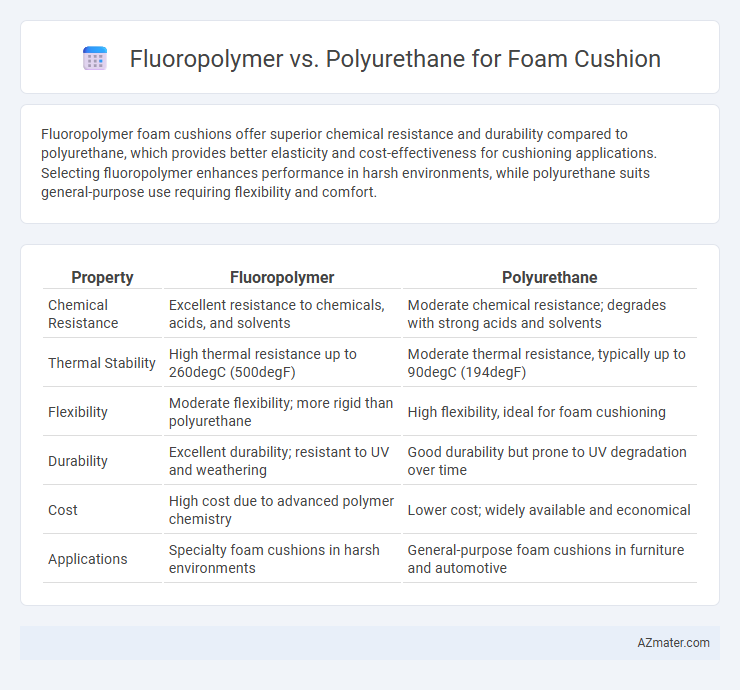Fluoropolymer foam cushions offer superior chemical resistance and durability compared to polyurethane, which provides better elasticity and cost-effectiveness for cushioning applications. Selecting fluoropolymer enhances performance in harsh environments, while polyurethane suits general-purpose use requiring flexibility and comfort.
Table of Comparison
| Property | Fluoropolymer | Polyurethane |
|---|---|---|
| Chemical Resistance | Excellent resistance to chemicals, acids, and solvents | Moderate chemical resistance; degrades with strong acids and solvents |
| Thermal Stability | High thermal resistance up to 260degC (500degF) | Moderate thermal resistance, typically up to 90degC (194degF) |
| Flexibility | Moderate flexibility; more rigid than polyurethane | High flexibility, ideal for foam cushioning |
| Durability | Excellent durability; resistant to UV and weathering | Good durability but prone to UV degradation over time |
| Cost | High cost due to advanced polymer chemistry | Lower cost; widely available and economical |
| Applications | Specialty foam cushions in harsh environments | General-purpose foam cushions in furniture and automotive |
Introduction to Foam Cushion Materials
Fluoropolymer and polyurethane are common materials used in foam cushions, each offering distinct properties that affect performance and durability. Fluoropolymer foams are known for their exceptional chemical resistance, weatherability, and thermal stability, making them ideal for specialized industrial or outdoor applications. Polyurethane foams provide superior cushioning, flexibility, and cost-effectiveness, widely utilized in furniture, automotive seating, and bedding products.
Overview of Fluoropolymer Properties
Fluoropolymers exhibit exceptional chemical resistance, low surface energy, and excellent thermal stability, making them ideal for foam cushion applications that demand durability in harsh environments. These materials offer superior weathering properties and resistance to solvents and aggressive chemicals compared to polyurethane foams. The inherent non-stick and low friction characteristics of fluoropolymer foams enhance their performance in high-wear, industrial cushioning settings.
Key Features of Polyurethane in Foam Cushions
Polyurethane foam cushions provide exceptional versatility with a wide range of densities and firmness levels, making them ideal for personalized comfort and support. Their open-cell structure enhances breathability and moisture resistance, contributing to durability and long-lasting performance in seating applications. Polyurethane foams also offer superior shock absorption and resilience, maintaining shape and cushioning effectiveness over extended use.
Durability and Longevity Comparison
Fluoropolymer foam cushions exhibit superior chemical resistance and UV stability, resulting in enhanced durability and extended longevity in harsh environments compared to polyurethane foams. Polyurethane cushions provide excellent initial comfort and flexibility but tend to degrade faster under exposure to moisture, heat, and abrasion. The inherent resistance of fluoropolymers to oxidation and environmental stress cracking significantly prolongs foam lifespan in demanding applications.
Resistance to Chemicals and Moisture
Fluoropolymer foam cushions exhibit superior resistance to a wide range of aggressive chemicals, including acids, bases, and solvents, due to their highly stable carbon-fluorine bonds, making them ideal for harsh chemical environments. Polyurethane foam cushions, while offering excellent comfort and flexibility, are more susceptible to degradation when exposed to moisture and certain chemical agents, leading to potential swelling or breakdown over time. Fluoropolymer's inherent hydrophobic properties also ensure minimal moisture absorption, enhancing durability and maintaining physical integrity in wet or high-humidity conditions.
Comfort and Support Performance
Fluoropolymer foam cushions offer superior durability and chemical resistance, maintaining consistent support and shape over extended use, which enhances comfort for long-term applications. Polyurethane foam cushions provide excellent initial softness and flexibility, adapting quickly to body contours for immediate comfort, but may compress and lose support faster under heavy or prolonged pressure. Choosing between fluoropolymer and polyurethane depends on the need for long-lasting resiliency versus softer, more adaptive cushioning performance.
Environmental Impact and Sustainability
Fluoropolymer foam cushions demonstrate chemical resistance and durability but pose significant environmental concerns due to their persistence, bioaccumulation potential, and challenges in recycling or safe disposal. Polyurethane foams offer better biodegradability and energy-efficient manufacturing processes, though they rely on petrochemical resources and can emit volatile organic compounds during production and degradation. Selecting sustainable foam cushions requires balancing fluoropolymers' long lifespan and environmental persistence against polyurethane's lower ecological footprint and compostability potential.
Cost Effectiveness and Market Availability
Fluoropolymer foam cushions offer superior chemical resistance and durability but come at a significantly higher cost compared to polyurethane foams, which are widely favored for their affordability and versatility in various cushioning applications. Polyurethane foam dominates the market due to its broad availability and cost-effectiveness, making it the preferred choice for mass production in industries such as furniture, automotive, and packaging. Despite the premium price, fluoropolymer foams are chosen in niche markets that demand enhanced performance under extreme conditions where longevity outweighs initial expenditure.
Application Suitability: Fluoropolymer vs Polyurethane
Fluoropolymer foams excel in high-temperature and chemical-resistant applications, making them ideal for aerospace, automotive, and industrial environments requiring durability against harsh conditions. Polyurethane foams offer superior comfort, cushioning, and flexibility, widely used in furniture, bedding, and packaging where softness and resilience are critical. Selecting between fluoropolymer and polyurethane foam hinges on the specific application demands: fluoropolymers suit extreme environments, while polyurethanes provide enhanced ergonomics and shock absorption.
Conclusion: Choosing the Optimal Foam Cushion Material
Fluoropolymer foam cushions offer superior chemical resistance, thermal stability, and durability compared to polyurethane, making them ideal for high-performance applications requiring long-term reliability. Polyurethane cushions provide excellent flexibility, cost-effectiveness, and comfort, suitable for general-purpose use where moderate resilience and cushioning are needed. Selecting the optimal foam cushion material depends on the specific application's exposure conditions, mechanical demands, and budget constraints to ensure optimal performance and longevity.

Infographic: Fluoropolymer vs Polyurethane for Foam Cushion
 azmater.com
azmater.com